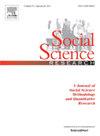美国中小城市绿色暴露的社会不平等:基于流动性的方法
IF 3.5
2区 社会学
Q1 SOCIOLOGY
引用次数: 0
摘要
接触绿色空间被认为对人们的身心健康至关重要。研究人员调查了基于个人居住地点的绿色空间暴露不均,这可能会加剧健康差异。基于流动性的方法可以更准确地评估日常活动模式中的绿色暴露。此外,社会不平等可能因地理环境而异,应加以审查,以处理环境正义问题。研究目标有两个:通过基于流动性的绿色暴露评估来解决暴露评估研究中的方法学挑战;并探讨基于流动性的方法是否比基于家庭的测量方法能更好地评估绿色暴露不平等。方法我们选择了25个美国中小城市作为研究地点,从中收集了50,823条步行通勤轨迹的街景图像。我们将语义分割技术应用于街景图像,以估计个人家庭和交通的绿色暴露水平。结果交通绿色暴露与居家绿色暴露存在显著差异。在全球范围内,较富裕的个人和非少数群体通过家庭和交通方式接触到的绿色空间明显多于他们的同行。在地方层面上,我们发现了县级绿地不平等的更细微的图景,这表明地方之间的关系是不同的。本研究提供了基于流动性的测量方法如何帮助我们评估暴露于城市绿色元素中的不平等问题的经验证据。影响创建符合当地不同情况的城市绿色走廊有助于为低收入和种族弱势群体公平地提供绿色基础设施,这些人群在其居住地不受欢迎。本文章由计算机程序翻译,如有差异,请以英文原文为准。
Social inequalities in green exposure in small- and medium-sized U.S. cities: A mobility-based approach
Background
Green space exposure has been considered essential for people's physical and mental health. Researchers have investigated uneven exposure to green space based on individuals' home locations, which may exacerbate health disparities. A mobility-based approach enables a more accurate assessment of green exposure in daily activity patterns. In addition, social inequalities may vary by geographical context and should be examined to address environmental justice concerns.
Objective
Study objectives are twofold: to address methodological challenges in exposure assessment studies through mobility-based assessment of green exposure; and to explore whether mobility-based approach can better assess green exposure inequality than home-based measurement.
Methods
We selected 25 small- and medium-sized U.S. cities as study sites, from which street-view images were collected along 50,823 walk-based commute trajectories. We applied a semantic segmentation technique to street-view images to estimate individual home- and mobility-based green exposure levels.
Results
Results revealed that mobility-based green exposure significantly differs from home-based green exposure. Globally, wealthier individuals and non-minority groups experience significantly greater exposure to green space through both home- and mobility-based approaches compared to their counterparts. Locally, we found more nuanced pictures of green space inequalities when compared at the county level, suggesting locally varying relationships.
Significance
This study suggests empirical evidence on how mobility-based measurements could help us assess inequality problems in exposure to urban green elements.
Impact
Creating urban green corridors that comply with locally varying contexts can contribute to achieving equitable provision of green infrastructure for low-income and racially disadvantaged populations who have undesirable green exposure in their residential locations.
求助全文
通过发布文献求助,成功后即可免费获取论文全文。
去求助
来源期刊

Social Science Research
SOCIOLOGY-
CiteScore
4.30
自引率
4.00%
发文量
0
审稿时长
65 days
期刊介绍:
Social Science Research publishes papers devoted to quantitative social science research and methodology. The journal features articles that illustrate the use of quantitative methods in the empirical solution of substantive problems, and emphasizes those concerned with issues or methods that cut across traditional disciplinary lines. Special attention is given to methods that have been used by only one particular social science discipline, but that may have application to a broader range of areas.
 求助内容:
求助内容: 应助结果提醒方式:
应助结果提醒方式:


